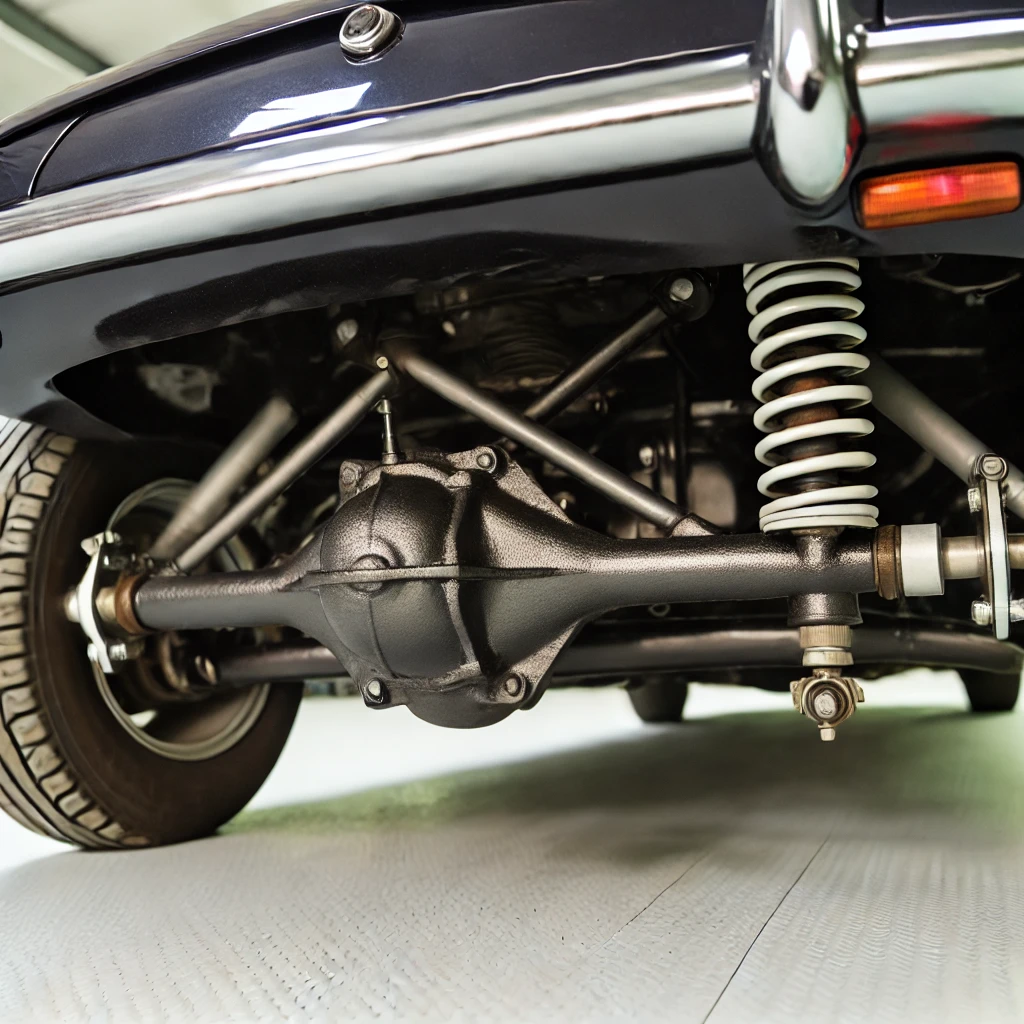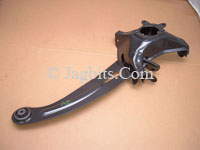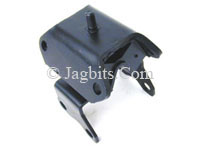By Gary Ilcyn, CEO and Jaguar Enthusiast at Jagbits Inc.
The Jaguar MK2, produced between 1959 and 1967, is a quintessential example of British automotive engineering, celebrated for its sleek design and exceptional performance. A critical component of its performance lies in its rear suspension system. Understanding this system not only provides insight into the vehicle’s handling and comfort but also into the innovative engineering practices of the era.
The Basics of the Live Axle
The rear suspension system of the Jaguar MK2 is a live axle setup, which was typical of many vehicles of the time. This setup is characterized by its robust and straightforward design, contributing to the car’s reliability and ease of maintenance. However, within this seemingly simple arrangement lies a series of sophisticated engineering decisions that enhance the vehicle’s performance.
A live axle system means that the axle is a solid beam that moves with the wheels. Unlike independent suspension systems where each wheel can move independently, in a live axle setup, the wheels are connected by a single rigid axle. This design has several implications for the vehicle’s dynamics. On one hand, it provides strength and durability, making it well-suited for the Jaguar MK2’s powerful engine and high-speed capabilities. On the other hand, it can lead to a less smooth ride over uneven surfaces since the movement of one wheel affects the other.

Leaf Springs: The Backbone of the System
The Jaguar MK2 employs semi-elliptical leaf springs for its rear suspension. Leaf springs are a type of spring made from layers of steel stacked in a slight curve. When the vehicle moves over a bump, the springs flex, absorbing the impact and providing a smoother ride. The use of leaf springs in the MK2’s rear suspension is a nod to traditional engineering, yet their implementation is finely tuned to balance performance and comfort.
Leaf springs offer several advantages. They are durable and can handle heavy loads, which is crucial for a performance car like the MK2. Additionally, they contribute to the vehicle’s stability during acceleration and cornering. The downside is that they can be stiff, and without proper tuning, they might lead to a harsher ride. However, Jaguar’s engineers managed to strike a balance, providing a suspension setup that complements the car’s sporty yet luxurious nature.
Historically, leaf springs have been used in vehicles for centuries, dating back to horse-drawn carriages. Their simplicity and effectiveness made them a popular choice well into the 20th century. In the context of the Jaguar MK2, these springs had to be carefully calibrated to handle the car’s performance requirements while ensuring a level of comfort expected from a luxury sedan. The engineering behind these springs involved precise calculations of load distribution, spring rate, and damping characteristics.
Shock Absorbers: Controlling the Ride
In conjunction with the leaf springs, the Jaguar MK2 uses telescopic shock absorbers. These shock absorbers are critical for controlling the motion of the springs and maintaining tire contact with the road. Shock absorbers dampen the oscillations of the springs, preventing excessive bouncing after hitting a bump and ensuring a smooth ride.
The MK2’s shock absorbers are designed to provide a balance between comfort and performance. They help to control the movement of the rear axle, reducing body roll during cornering and maintaining stability at high speeds. This setup is particularly important for a car like the MK2, which was often driven enthusiastically and expected to handle well under various conditions.
Shock absorbers convert the kinetic energy of the suspension movement into thermal energy, which is dissipated through the hydraulic fluid inside the shock. This process helps to smooth out the ride and maintain stability. For the Jaguar MK2, the choice of shock absorbers would have involved extensive testing and fine-tuning to achieve the desired balance. Modern enthusiasts often upgrade these components with newer technology that offers improved performance, but the original setup remains a testament to the car’s engineering.
The Panhard Rod: Ensuring Lateral Stability
One of the key components of the Jaguar MK2’s rear suspension is the Panhard rod. The Panhard rod is a lateral stabilizer that connects one side of the axle to the opposite side of the car’s chassis. Its primary function is to control lateral movement of the axle, ensuring that the rear wheels remain aligned with the car’s body during cornering.
The Panhard rod is crucial for the handling characteristics of the MK2. It prevents the axle from moving side to side, which could lead to instability during high-speed maneuvers. By keeping the rear axle in a fixed lateral position, the Panhard rod helps maintain precise handling and improves the overall driving experience.
The concept of the Panhard rod dates back to early 20th-century automotive design. Its implementation in the Jaguar MK2 showcases how even a relatively simple component can significantly impact a vehicle’s performance. The rod must be precisely aligned and securely mounted to function effectively, and any wear or damage can lead to degraded handling. Owners of classic cars often pay close attention to the condition of the Panhard rod and its mounts, as maintaining them is essential for preserving the car’s original driving dynamics.
Evolution of the Design
The rear suspension of the Jaguar MK2 is a product of its time, designed to provide a balance between performance and comfort. However, it’s interesting to note how suspension design has evolved over the years. Modern cars often use independent rear suspension systems, which allow each wheel to move independently, providing a smoother ride and better handling.
Despite this evolution, the live axle and leaf spring setup of the MK2 has its own set of advantages. It’s simpler and more robust, making it easier to maintain and repair. For classic car enthusiasts, this setup also offers a more connected and engaging driving experience, as it requires more skill to handle effectively compared to modern, highly refined suspension systems.
The transition from live axle to independent suspension systems in modern cars represents a significant shift in automotive engineering. Independent suspensions provide superior handling and comfort, as they allow each wheel to react individually to road conditions. However, the live axle’s simplicity and durability make it a popular choice for certain applications, such as heavy-duty trucks and off-road vehicles. For the Jaguar MK2, the live axle setup was a well-considered choice that balanced performance with the technological constraints of the era.
Note:
* This article has been peer-reviewed and held to the highest editorial standards.
** Image may not represent actual part.
Maintenance and Upgrades
Maintaining the rear suspension of a Jaguar MK2 requires a good understanding of its components. Regular inspection of the leaf springs, shock absorbers, and Panhard rod is essential to ensure they are in good condition. Over time, leaf springs can sag and lose their effectiveness, while shock absorbers can wear out and fail to dampen the suspension properly.
For enthusiasts looking to enhance their MK2’s performance, several upgrades are available. Upgraded shock absorbers with modern damping technology can provide a smoother and more controlled ride. Some owners opt to replace the original leaf springs with modern equivalents or even convert to coil spring setups for improved performance.
In addition to these mechanical upgrades, it’s important to consider the condition of the mounting points and bushings. Worn or damaged bushings can lead to increased play in the suspension, reducing handling precision. Upgrading to modern polyurethane bushings can provide better durability and performance. Additionally, ensuring that all components are properly lubricated and free from corrosion is essential for maintaining the suspension’s integrity.
Driving Experience
The Jaguar MK2’s rear suspension transforms the driving experience, marrying performance with comfort. Its live axle, leaf springs, and shock absorbers create a planted, stable feel at high speeds. The robust axle and Panhard rod ensure lateral control but demand respect from drivers due to its less forgiving nature compared to modern systems.
Driving a Jaguar MK2 is a nostalgic experience, offering a direct connection to the road that is often missing in modern cars. The suspension setup, while not as sophisticated as contemporary designs, delivers a raw and engaging driving experience. It requires the driver to be more involved, providing feedback through the steering wheel and seat, making every drive an event.
Driving a Jaguar MK2 feels like a dance, where man and machine move in perfect harmony. The responsive suspension and steering let you sense every twist and turn of the road, making each drive exhilarating. Its balanced suspension handles both spirited drives and relaxed cruises effortlessly, embodying versatility in a classic car.
***
The Jaguar MK2’s rear suspension showcases the brilliance of mid-century engineering. Blending classic design with cutting-edge solutions, it delivers a ride that’s both thrilling and smooth. Delving into its mechanics reveals not just technical mastery but also the ingenuity behind one of Jaguar’s most legendary models.
Owning a Jaguar MK2? Keep its rear suspension in top shape. Regular checks and timely upgrades ensure peak performance, preserving the thrilling drive this classic promises. The Jaguar MK2’s iconic status hinges on such meticulous care—it’s what keeps this beloved legend roaring.
Exploring the Jaguar MK2’s rear suspension reveals a perfect blend of simplicity and sophistication. Original or upgraded, this classic car’s suspension delivers a timeless, exhilarating driving experience.









